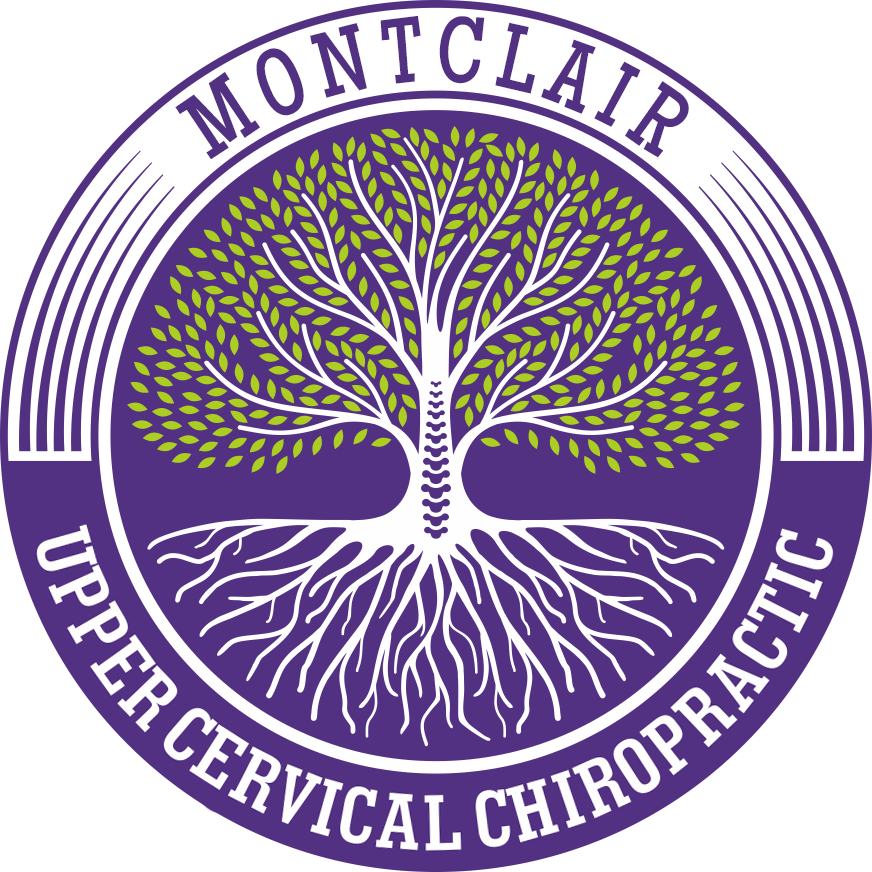
A chiropractor with a specialty in sports medicine, Dr. Bradley Maestas talks about his field and experiences. He shares when he first started his journey towards being a chiropractor and his love for sports. Putting the two together, he went on to specialize in sports chiropractic. He shows his expertise while mixing in acupuncture practices like cupping plus using RockTape. He also touches on the topics such as posture and some innovations in the sports medicine industry that he is interested in.
We have Dr. Brad Maestas out of Albuquerque, New Mexico. Dr. Brad is a chiropractor with a specialty in sports medicine and is one of the chiropractors for the University of New Mexico. Dr. Brad uses an acupuncture technique called Cupping to help his athletes recover and heal through old injuries faster than expected. He also uses RockTape or some people might know it as Kinesio Taping to help create more blood flow and heal musculoskeletal injuries. On top of all that, Dr. Brad is a phenomenal chiropractor. You get a phenomenal treatment base that addresses all of your musculoskeletal injuries and conditions while seeing Dr. Brad. Please welcome, a good friend of mine, Dr. Brad.
Listen To The Episode Here
Dr. Bradley Maestas on Athletes, Cupping, And Sports Chiropractic
We have Dr. Brad Maestas. He is a chiropractor who does a lot of soft tissue work and trains with a lot of athletes at the University of New Mexico. He is a talented doctor. He was one of my first friends in chiropractic school. It’s an honor to call him a good friend and a fellow chiropractor. Brad, how are you doing?
I’m good. Thanks for having me. I appreciate it.
Brad, where are you from originally?
I was born and raised in Albuquerque, Mexico.
What did you do for fun growing up?
I did a lot of outdoors activities and sports my whole life. I did a lot of fishing and hunting. I played football, wrestled, and then I did track and field.
You did a lot of hunting growing up. What did you use to hunt for?
Elk, deer, I’ve done a little bit of everything.
Is there a certain connection that you have with the food that you hunt when you bring it back to the table? That’s pure, organic meat that you’re eating. What is that like eating that stuff?
It makes your body feel clean. Your mind knows this came from the wilderness. It’s not store-bought, force-fed or anything. Elk meat is one of the highest protein red meats you can get. It’s up there. You know it’s clean and good for your body. It’s low-fat content, all that stuff makes you feel clean inside.
After you eat a big steak and everything, you feel it sit in your stomach forever. You don’t get that feeling when you’re eating elk and stuff that you bring home?
I never feel bogged down or greasy from eating it. I’ll take it to the butcher and he’ll make me breakfast sausage out of elk and deer. You eat it in every meal and it’s not just eating the same stuff, which is nice.
EM 73 | Sports Chiropractic
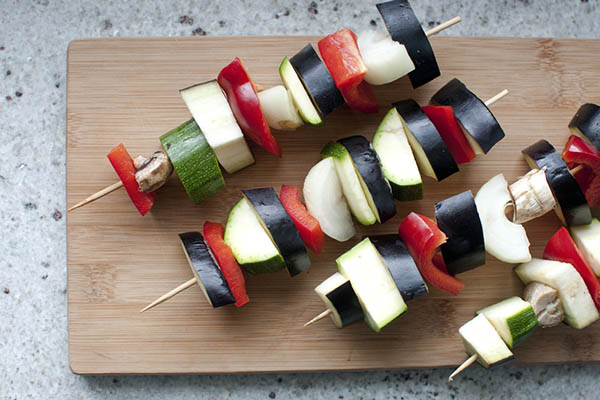 Sports Chiropractic: Your mind knows what you’re eating. Eating organic makes your body feel clean.
Sports Chiropractic: Your mind knows what you’re eating. Eating organic makes your body feel clean.
What sports were you into growing up?
My main one was football. Most people don’t know that I went to the University of Mexico and started with track and field and threw the hammer and discus.
That’s what you were recruited for?
Yes. Football offered me a scholarship to switch over. That’s when I started playing football again.
When did you discover you had a talent for throwing the discus?
That was in high school. I started with a javelin, but I ended up tearing my rotator cuff in wrestling. The discus ended up becoming a better option for me to throw because javelin is like throwing a baseball.
Were you naturally gifted at it in the beginning?
I was awful. I was terrible. Hammer is an event that you can’t do in high school. It’s something that a lot of people don’t do until college. I did it at what was called the South West Games. The first time I ever did it, the coach saw me do it and saw that I had potential. That was what I was gifted at. It wasn’t so much the discus.
Did you play football in high school or is that something you just picked up?
I played in high school since I was twelve. I was always a lineman, you know me, 6’5” and 270 pounds. I’m a big guy. I played all the way through high school. I didn’t play college until my last two years of eligibility. That’s how I got into chiropractic.
Why’s that?
I tore my ACL, MCL meniscus. They started getting me adjusted because my hips were off from being in that leg cast for three to four months. It messes up your low back and everything.
What was chiropractic able to do for you?
When I first started doing rehab, they don’t let you do lateral mobility. You slowly start getting it. When I started being able to run again, I always felt something’s off. The chiropractor started coming in and he started doing all the muscle work on top of adjusting my sacroiliac joint. I noticed a huge change in power and I could run without hesitation.
Was this relatively new to you? Did you ever go to the chiropractor before?
I hadn’t, that was my first.
After getting chiropractic care and helping out your leg, you’re like, “This is what I need to do.”
I was originally looking going into cardiology school.
That’s an interesting field to choose. Why had you chosen that?
I’ve always been fascinated with the body. I know a lot of people that have heart issues. I was like, “I want to learn more about this.”
I remember having one of those classes where we’re reading the cardiograms and everything. You were glued to it. Everybody was done and you’re like, “Check this out. Look at this.” You had a fascination with it.
You always find that one thing that interests you. That’s what led me into all the mild fascial work as well because then you start learning about the heart muscle. The heart’s a giant muscle and then I was like, “What’s the rest of the body needs?” That snowballed to where I am now.
What are you doing now? What are the types of patients you see? Are you working with mostly athletes? Do you have a family practice too or is it strictly athletes?
It’s a mix. It’s a family practice, but I do see a high volume of athletes. Where I’m talking to you from is inside of a mixed martial arts gym. I’m here two days a week and I see a lot of their athletes. We have a lot of people that come in and learn how to do boxing, Muay Thai. They will come to see me here as well. I have that aspect. The other office is where the UNM will send their athletes if they need it. We also have the triathletes. That’s where the family wellness comes into play. We’re moving into a bigger office here so we can do more physical therapy.
What are you doing with these athletes?
A little bit of everything. The first time they come in, it depends on what they need. If it’s a fighter where I have to get them better in a week, I’ll usually go straight to moving cupping stuff on them and then we move it up. I always go along the strands of the muscle.
What is cupping? Did that start with acupuncture?
It did. Cupping is originally an acupuncturist’s type of medicine. You take a cup and you suction it to the body. There are multiple ways of doing it. There are silicone cups, like those old finger poppers that will suck your skin. The vacuum ones are what I use more. There’s the fire cupping where you light a cotton swab, put it inside the cup until the oxygen’s gone, then you can stick to the body.
EM 73 | Sports Chiropractic
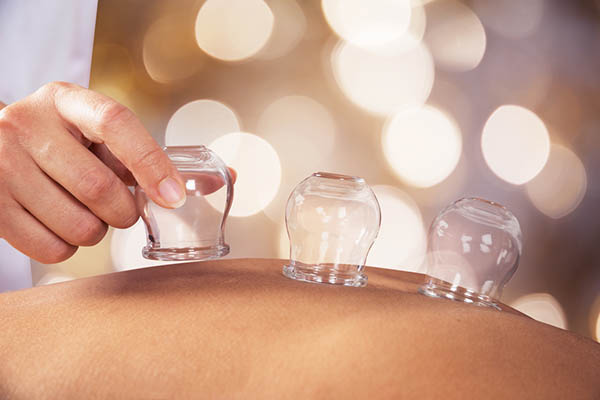 Sports Chiropractic: When you do cupping, you’ll see certain parts of inflammation that has been pulled towards the surface.
Sports Chiropractic: When you do cupping, you’ll see certain parts of inflammation that has been pulled towards the surface.
What are the medical benefits of cupping?
The most fascinating part is if I do stagnant cupping, you’ll see the spots of inflammation. You know where there’s been a chronic injury because that cup will turn dark. I never leave them on more than a minute. It takes 30 to 45 seconds for that cup to turn dark if it’s going to. The cup right next to it might not change at all. That tells me that your blood flow has not been circulating correctly in that area compared to the rest. That inflammation is being pulled towards the surface. Now all that new blood flow, the protein, the carbs, everything that you need to make your muscles heal gets put back in there.
Does it help you out chiropractically as well as knowing where to pinpoint? Where to start looking for any subluxations or anything out of place?
Not necessarily. Hands are first. I’ll go through and feel what’s going on. Once I figure like, “This person’s T4 rib is subluxated on the right,” I’ll go through and put those cups along the intercostal above and below. That brings all the blood flow on there so they relax. When you adjust, instead of doing that hard, forceful adjustment, it’s nice and easy.
It brings the blood flow back to the area and decreases inflammation, is there anything else it’s doing for you?
Not really, it depends on how I’m doing it. I also do it with motion. When I have somebody with a rotator cuff, their whole back will be covered in cups. I’ll make them go through every range of motion for the rotator cuff. You’re talking your supraspinatus, region behind the back going across the body.
That’s like ART with cupping.
I even have cups now that have a little pressure point in the center of them, so you get that acupressure. It’s lifting the skin into that point to get that trigger point released as well.
After you’re cupping, people can have marks on their body. Does it hurt? What does that feel like?
Most people don’t even notice them. They’ll have no idea unless you show them. You’re like, “This is what’s going on.” It’s usually not tender. That’s where stuff like my RockTape comes in handy.
What is RockTape? I know there’s a couple different. There’s Kinesio Tape, there’s RockTape. Please go into the benefits of RockTape, Kinesio Taping, and all that stuff.
The benefits are endless. A big one for me is they have a lymphatic drainage tape and it looks like fingers. If you overlap them, it’ll decrease the time it takes for your bruise to heal in half, if not, faster than that. That’s the RockTaping. That’s how I use it in conjunction with the cupping. I’ll put it over the cup marks and those heal up faster. What it does is it’s got rubber inlaid in the elasticity of it that lifts the skin. You’re getting that constant relief. Blood’s able to move and circulate much faster than it would if it didn’t. You also have all your supportive stuff.
Kinesiology Tape, that’s the big thing is everyone thinks, “I don’t do tapes. It’s going to restrict me.” KT Tape, RockTape, all that tape, it moves with you. It’s not a restrictive tape. It’s not something where I’m going to tape your knee and I’m telling you, “Don’t worry. Your ACL is supported.” It’s not like that. It’s facilitating muscles and everything else, too. You’re getting that proprioceptive reaction so everything’s preemptively firing. That way you’re less likely to add the injury, but it also is going to give you the benefits of getting that blood to heal yourself.
Do you encourage your athletes to use it while they’re playing their sport? Do you tell them, “Wear this for a couple days and take it off when you’re playing?”
It depends on what they’re doing. Let’s say we’ve been treating the shoulder and I’ve been taping it up while they’ve been practicing. I’ll make them play with it taped because they’re used to having them. I don’t want to change the way that they’ve been functioning in a competition as the way they’ve been practicing. It all depends. Finally, if I have them wear tape for two days and then they have a couple of days of practicing the game, I won’t let them take for the game. I want them to stay in that function of what they’ve been practicing.
How long does the tape last for? I’m sure it varies per patient and what they’re doing.
Different brands are different. The main reason I use RockTape is they have an H2O brand, which they use with their swimmers. I will put that on patients and they can have it up to two weeks. That’s with them showering, everything. It all depends on your body as well. If you’re somebody that has a high, oily sweat, it’s going to appeal faster than somebody that doesn’t. It’s also a fabric material, it breathes. It’s not going to let that sweat sit underneath it.
You see it restoring blood flow, restoring movement and healing up injuries faster. Anything else you see?
That’s pretty much the two major components for that on my aspect of it.
What about posture? What if someone’s just got bad posture? Can you put that on them to train them to remind them?
EM 73 | Sports Chiropractic
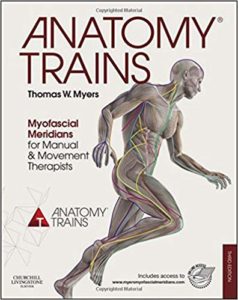 Anatomy Trains: Myofascial Meridians for Manual and Movement Therapists
Anatomy Trains: Myofascial Meridians for Manual and Movement Therapists
Yes, 100%. I don’t do that as much. Do you remember going to seminars and seeing those postural shirts that have the weird stripes all over them? You can do that same stuff with this. It’s a fascial training. If you ever get the book about fascial trains, Anatomy Trains, it’s the best thing ever. If you tape along those fascial trains, you’ll see people’s posture automatically being facilitated to go back to normal.
When you’re at your regular chiropractic, it’s pretty standard to see patients X amount of times a week depending on their condition. You have people that are coming to you, they’re like, “I’m playing on Friday. You’ve got to get me better.” How does that work?
It depends on the circumstance. Basically, we’re doing all the muscle therapy. Whether I’m doing percussion therapy with the TheraGun, the Hypervolt, or we’re doing cupping or something, I’ve got to get those muscles functioning again. Otherwise, I’m telling them, “No, you can’t play.” Most of my athletes, they’re going to do it whether I tell them not to. That’s an athlete. My whole goal is every time they come in, I’m trying to drop them down from where they were by 50%. They should be 50% better every time they leave my office.
Do you have to see some of these people twice a day if it’s crunch time?
If it’s crunch time, usually not. The most I’ve seen someone is three times a week and it’s not even adjusting every time. Sometimes I’m just doing the muscle therapy. We’re seeing your fascia. We’re going through depending on what you need. Maybe I’ll put them on decompression table or we’ll put them up to the light compression sleeves to let blood flow get forced out and back in. I always see chiropractic as more than just an adjustment. It’s our duty to do more than adjust.
With athletes, they don’t like to be over adjusted. The big thing is they don’t like feeling they’re being overworked when it comes to their spine. You have to take a different course with them as opposed to your average patient were like, “Your occiput C1, every three or four days is wind lockup. We’re working on why it is, but we need to keep releasing it.” Your athlete’s going to be like, “Leave it. I’ve been practicing with it.” It’s a tough thing. There’s a gentle fine line of what you’re able to do and what you should be doing.
Do you ever find yourself having to change the athlete’s ergonomics? Let’s say their alignment had this constant injury and with the way they’re standing when they’re playing, do you ever have to go into that field to make sure they’re not injuring themselves the way they’re standing or they’re playing?
I do that a lot. Being a former lineman and defense, I know what it’s like going up against offense guys. You never see yourself unless you’re watching the film, but you always see that offensive lineman. I know when an offensive lineman comes in my office like, “My hip’s hurting,” I know already why. I make them go and I’m like, “Show me your position. Let’s see how you do this,” just to prove that I already knew. Most of the time, it’s all positioning. They leaned wrong, they twisted this way instead of keeping the position that they’re supposed to and are taught to. They gave out that one time.
The sports medicine field is constantly being updated with new technology and equipment to heal people. Do you see anything out now that you’re dying to get into and test out? Anything new or are you happy with the tools you got now?
There are a lot of tools that I would love to have. Once my practice is up and really moving, there’s stuff like the Teker. It’s almost like an ultrasound but intensified. It’s reducing fracture healing time. The first time I saw it was with Dr. Kessler in Tustin. He’s also known as the OC Fight Doc, which is how I got into MMA. He was using it and I’ve been watching the research grow on it and everything. Now it’s becoming a little bit more popular. They’re very expensive.
EM 73 | Sports Chiropractic
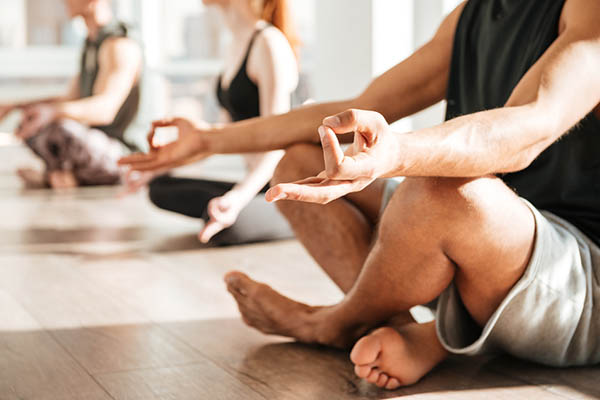 Sports Chiropractic: Take care of your body. Don’t wait until there’s an injury. If you start now, it’s preventive.
Sports Chiropractic: Take care of your body. Don’t wait until there’s an injury. If you start now, it’s preventive.
Do they have any laser therapy or anything at the facility you’re at? Even at the university?
We don’t use so much the laser therapy. Something I’m looking into doing is doing my dry needling certification.
I heard that gets great results.
It does. People love it, whether they’re athletes or not. That’s something that the doctor I worked with at my other office does all the time. He’s been telling me I need to go get the class. Once I can have that free time and get up and going, I’m going to be getting that.
Football season is starting up and you’re going to be a pretty busy guy these next couple of months.
Believe it or not, track season is easier than football season. There are a lot more of athletes come in saying, “They pulled their hamstring. I tweaked my hip flexor.” Football is usually the sport where unless something’s really hurt, they’re going to push through it until the end. As soon as football season ends, a month or two where they’re coming in one after the other.
Where are you located? Where can people find you and come in and see you?
On Monday, Wednesday, Fridays I’m located with Speegle Sport and Spine. Most people around town know Dr. Speegle played for UNM as well. He ended up going and playing for the Browns. A lot of people know who he is. I’m at Luttrell/Yee MMA gym on Tuesdays and Thursdays.
You have a website too?
We’re working on the website now. The best way to contact me is going through social media, Facebook, Instagram. I have all my links on how to book online so you don’t call me to book an appointment.
What’s your Instagram handle?
If there’s one piece of advice you can give the audience that you’ve taken with over the years that resonated with you, it could be anything, what would it be?
Take care of your body. Don’t wait until there’s an injury. If you start now, it’s preventative. It’s going to make you last longer as opposed to fixing it when it’s broken and then we’re having to fix something. That’s my go-to for everyone.
I’m sure you learned that the hard way too.
Take it from me. I learned from my experience.
Brad, thank you much for coming on. Seems you’ve got something really amazing over there in New Mexico. I’m happy for you and I’d love to have you on anytime again.
I appreciate it. Anytime, you let me know. I’m always good to talk to you.
It was good catching up with you. I’ll talk to you soon.
Sounds good, have a good one.
Love the show? Subscribe, rate, review, and share!
Join Expect Miracles community today:
